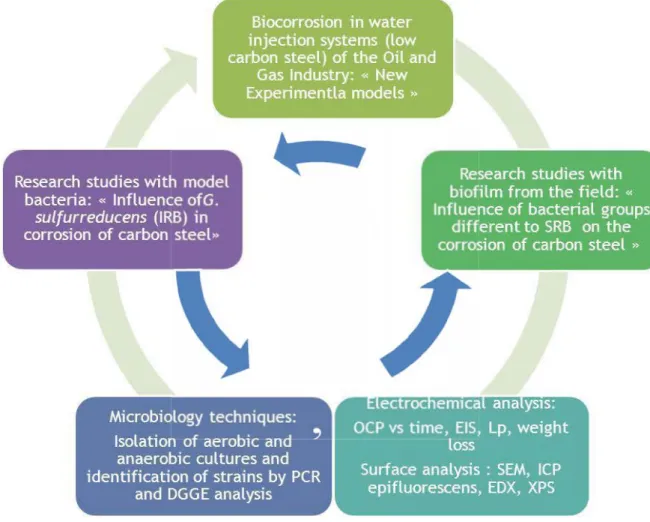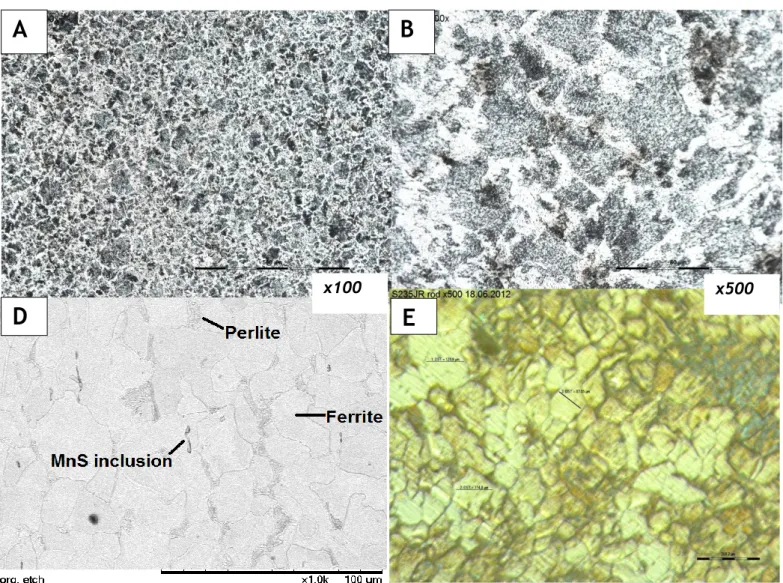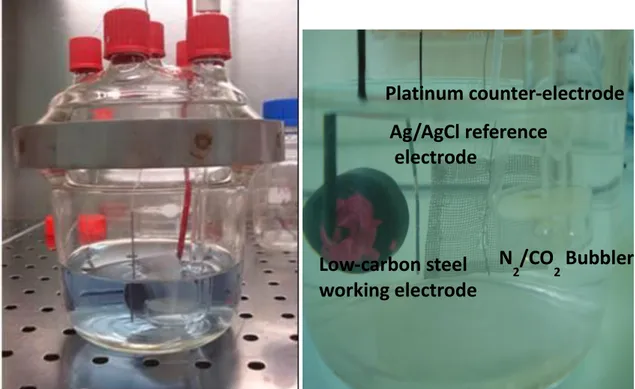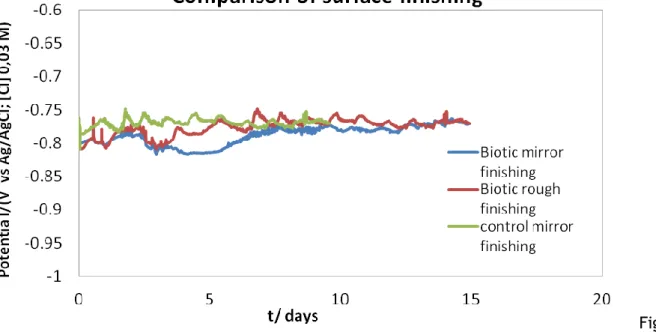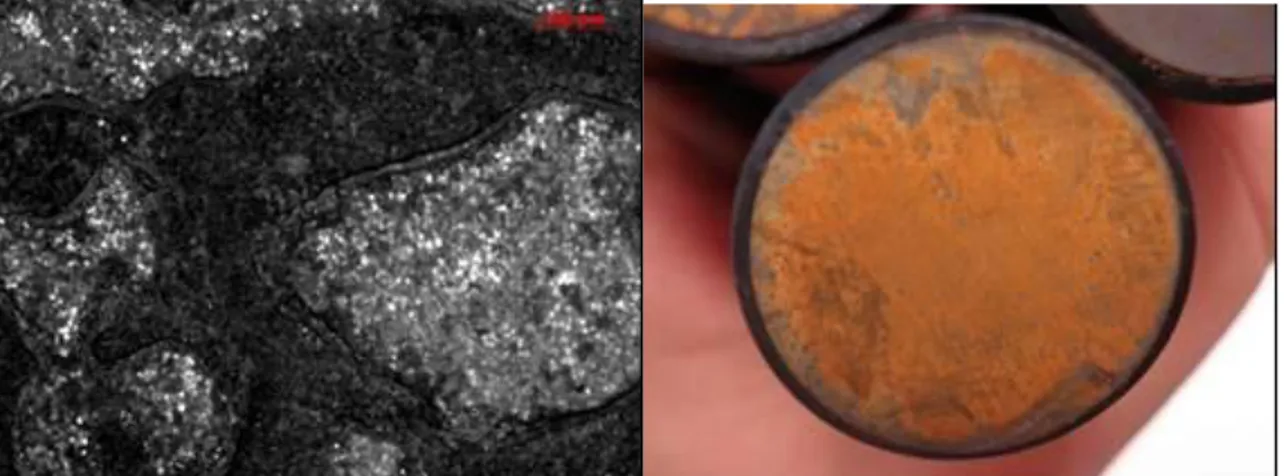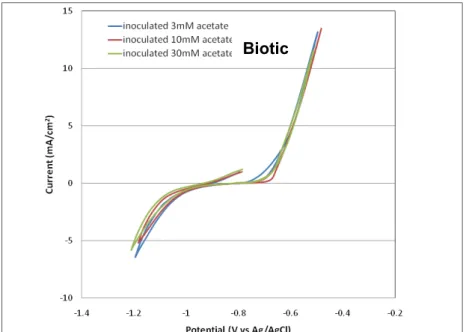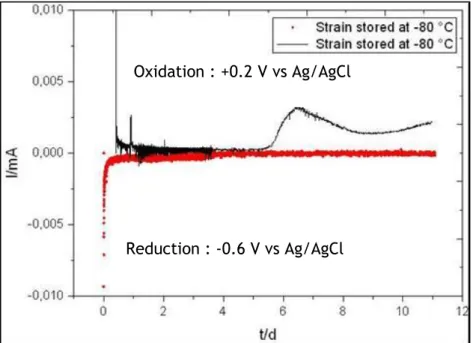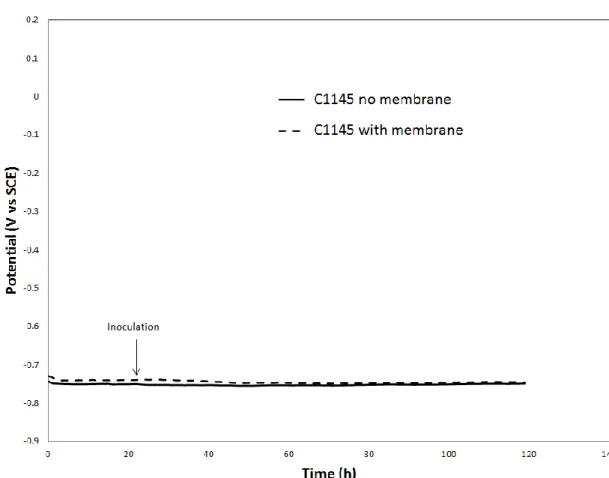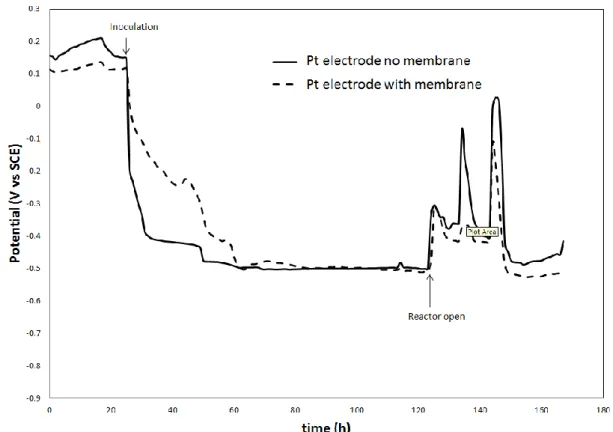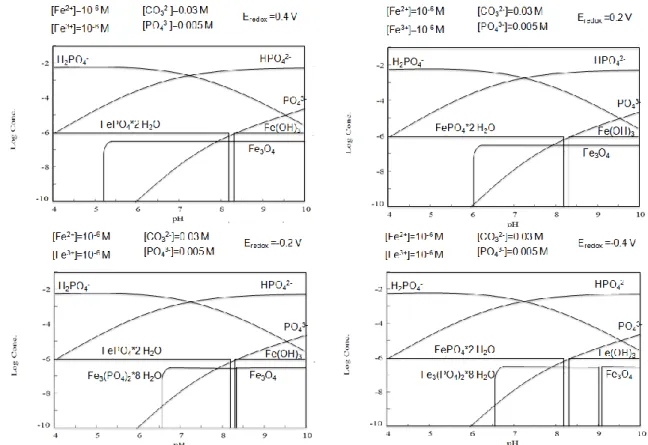() (Directrice de thèse) Mathieu BERGE (Co-directeur de thèse)
E 3
Abstract
The oil and gas industry is impacted by important economic losses due to corrosion problem. As part of this problem, microbially influenced corrosion (MIC) is still a subject of research. The most often evoked and well acknowledge MIC mechanism is linked to sulphate reducing bacteria (SRB). However, some studies have shown that MIC can occur even when SRB is not present in the corroding environment; in this framework, the main objective of the thesis is to provide new insights on corrosion of carbon steel caused by other mechanisms different to those described with SRB.
First, the influence of an electroactive strain, G. sulfurreducens (an iron reducing bacteria, IRB) on the corrosion/protection of steel C1145 was studied. When phosphate species are present in the medium, bacteria promote the formation of an iron phosphate layer (vivianite) that afterwards protects the material. In presence of NH4+, corrosion rates
are higher but bacteria decrease the dissolution of the material.
In the second part, field samples from pigging operations performed in water injection pipelines were analysed from microbiological and electrochemical corrosion points of view. Molecular analysis and identification of the biofilm community show the presence of sulfidogenic species besides SRB. These bacteria can stimulate metal corrosion through production of organic acids, CO2 and different sulphur species such as H2S. Moreover, it was
proved that the consortium contained in field samples accelerated corrosion of carbon steel mainly by production of sulphide species.
Key-words: Biocorrosion, carbon steel, MIC, anaerobic, Geobacter sulfurreducens
Biocorrosion de l'acier au carbone dans les systèmes d'injection d'eau de l'industrie du pétrole et du gaz: nouveaux modèles expérimentaux issus du terrain
Résumé
L'industrie pétrolière et gazière subie d‘importantes pertes économiques en raison de problèmes liés à la corrosion. Parmi ces problèmes, la corrosion induite par les micro-organismes (biocorrosion) fait toujours l‘objet de recherche, le mécanisme le plus souvent évoqué et documenté étant lié aux bactéries sulfato-réductrices (BSR). Cependant certaines études ont montré que la biocorrosion pouvait se produire même en absence de BSR dans l'environnement corrosif ; le principal objectif de la thèse était donc de fournir un nouvel éclairage sur la corrosion anaérobie de l'acier au carbone en proposant des mécanismes différents de ceux impliquant les BSR.
En premier lieu, l‘influence d'une souche électro-active, G. sulfurreducens, sur la protection/corrosion de l'acier C1145 a été étudiée. Lorsque des espèces phosphate sont présentes dans le milieu, la bactérie favorise la formation d‘une couche de Fer/Phosphate qui ensuite protège le matériau. En présence d‘ammonium, les vitesses de corrosion sont plus élevées mais les bactéries réduisent la dissolution du métal.
En deuxième partie, des échantillons de terrain issus des opérations de nettoyage des pipelines des systèmes d‘injection ont été analysés d‘un point de vue microbiologique et électrochimique. L‘analyse moléculaire et l‘identification de la communauté bactérienne montre la présence d'espèces sulfurogènes autre que les BSR. Ces bactéries peuvent stimuler la corrosion des métaux par la production d'acides organiques, de CO2 et de
différentes espèces soufrées telles que H2S. De surcroît, il a été prouvé que le consortium
contenu dans les échantillons de terrain accélérait la corrosion de l'acier au carbone, principalement par la production d'espèces sulfures.
4
Thanks to the financial support of the Centre National de la Recherche Scientific (CNRS), I was awarded a scholarship funded by the EU 7 frame work-Marie Curie program (FP7/2007-2013) allowing me to participate in the BIOCOR project. The project was under the grant agreement n° 238579. This work was performed in the Laboratory of Chemical Engineering (LGC) of the Institut National Polytechnique de Toulouse (INPT).
I would like to thank all the BIOCOR network team for their scientific support and constant suggestions during our meetings. Special thanks to all the people in LGC who since I arrived in France made me feel welcome and like at home, specially to my thesis director, Regine Basseguy, and the post-doc working in the LGC for the project, Omar Rosas, for their constant guidance and help teaching me electrochemistry. To the AXE 5 team and their enriching comments and great sense of humor which made a great environment for me during these three years.
Finally, massive thanks to all my family and friends who supported me and encourage me to do this PhD thesis and cheer me all along these years: To my mom, dad and sisters (Kate and Caro) who are my reasons for always wanting to be better. To my ―adoptive‖ parents (Danny and Roger) who made me always feel that I have an extended family in France and to my love and soon to be husband, Olivier, who made of the long writing hours happy moments.
5
6
GENERAL INTRODUCTION……….….9
CHAPTER I: STATE OF ART. CORROSION AND BIOCORROSION………13
I.1. Introduction……….………14
I.2. Electrochemical corrosion………15
I.2.1Types of corrosion……….……….………17
I.2.2 Corrosion detection techniques……….………20
I.3. Biocorrosion or Microbiologically Influenced corrosion……….20
I.3.1. Biofilms and corrosion……….22
I.3.2. Role of bacteria on the anaerobic corrosion of carbon steel ……….24
I.3.3. Bacteria groups involved in corrosion……….25
I.3.3.1. Sulphate reducing bacteria (SRB)………26
I.3.3.2. Iron oxidizing bacteria (IOB) and Manganese oxidizing bacteria (MOB): Metal depositing Bacteria MDB)……….…………...27
I.3.3.3. Iron reducing bacteria (IRB)……….28
I.3.3.4. Acid Producing bacteria (APB)………30
I.3.3.5. Methanogens……….31
I.4 Biofilms and microbiologically influenced corrosion inhibition (MICI)………31
I.5. Biocorrosion in the oil and gas Industry………33
I.6. Scope of the project……….36
CHAPTER II: MATERIALS AND METHODS………39
II.1. Materials and Media……….40
II.1.1. The working electrode………40
II.1.1.1. Nomenclature ……….41
II.1.1.2. Surface treatment ……….42
II.1.2. Reference and counter electrodes……… 42
II.1.3. Reactors……….43
II.2 Bacteria samples………43
II.2.1. Geobacter sulfurreducens………43
II.2.2. Bacterial consortia from pigging debris………44
II.3. Media………44
II.3.1. Geobacter sulfurreducens Growth media………44
II.3.2. Geobacter sulfurreducens reactor media………45
II.3.3. Pigging samples enrichment media……….45
II.3.3.1. Non selective media………45
II.3.3.2. Selective media……….46
II.3.3.3. Reactor media……….48
II.4. Methods……….48
II.4.1. Electrochemical and corrosion experimental techniques………48
II.4.1.1. Corrosion potential measurement………48
II.4.1.2. Polarisation resistance measurements………49
II.4.1.3. Chronoamperometry measurements……….51
7
II.4.1.5. Weight loss……….58
II.4.2. Microscopy techniques and surface analysis……….60
II.4.2.1. Scanning Electron Microscopy (SEM)……….60
II.4.2.2. Energy-dispersive X-ray spectroscopy (EDX)………60
II.4.2.3. X-ray photo electron spectroscopy (XPS)……….60
II.4.3. Planktonic cells measurement techniques……….61
II.4.3.1. Turbidity measurement by optic density (OD) technique………..61
II.4.3.2. Direct cells counting by Thomas chamber………61
II.4.4.Total iron determination………62
II.4.5. DNA extraction and strains identification………62
II.4.5.1. DNA extraction………..62
II.4.5.2. Polymerase chain reaction amplification (PCR)………63
II.4.5.3. Denaturing gradient gel electrophoresis analysis (DGGE)………63
CHAPTER III: ROLE OF Geobacter sulfurreducens IN THE ANAEROBIC CORROSION OF CARBON STEEL………65
III.1. Introduction……….66
III.2. Why to use Geobacter sulfurreducens for the corrosion studies………66
III.3. Preliminary experiments……….67
III.3.1. Influence of surface roughness………68
III.3.2. Influence of acetate concentration………70
III.3.3. Testing G. sulfurreducens electroactivity……….73
III.4. Results using standard reactor medium……….75
III.4.1. Article 1……….75
III.4.2. Article 2……….97
III.4.3. Supplementary results……….114
III.4.3.1. Polarisation results………114
III.4.3.2. Influence of fumarate concentration…….………120
III.5. Influence of medium composition………129
III.5.1. Influence of G. sulfurreducens in a medium without phosphate……….129
III.6. Weight loss results in the different media………138
III.7. General conclusions……….143
CHAPTER IV: CORROSION IN THE OIL AND GAS INDUSTRY………145
IV.1. Introduction………146
IV.2. Corrosion in the oil and gas industry and its causes……….147
IV.3. Problems to be solved………148
IV.4. Water injections systems and pigging samples……….149
IV.5. The work performed………151
IV.5.1. Microbiological results……….151
IV.5.2. Electrochemical and weight loss results……….166
8
IV.5.2.2. Supplementary results……….201 IV.6. Conclusions……….208 CHAPTER V: GENERAL CONCLUSIONS AND RECOMMENDATIONS……….210 REFERENCES
9
10
development, which occurs in almost all natural and man-made environments, is responsible for microbial influenced corrosion (MIC), also known as biocorrosion. The main factors necessary to develop MIC on metal surfaces besides the microorganisms are the presence of water, temperatures between -12 to +112 °C and a carbon source. Biocorrosion can be defined as the enhancement or acceleration of corrosion by the presence of bacteria [Beech and Gaylarde, 1999; Coester and Cloete, 2005; Beech et al., 2005]. However, MIC is not a new corrosion mechanism but it integrates the role of microorganisms in corrosion processes by, for example, affecting the electrochemistry of the system.
Corrosion and within its classifications MIC, is one of the main problems affecting different industries such as the oil & gas and power supply industries; costing them billions of Euros per year in costs and production losses. In the case of the oil & gas industry, nearly all the systems are prone to MIC. The main systems involved are: Oil separation train, produced water systems, water injection systems and oil export systems. In general, the corrosion of metals has a significant impact on the worldwide economy. Different studies have shown that the economic losses due to corrosion represent at least 4% of the gross national product (GNP) [Duncan et al., 2009]. For example, the French Centre of Corrosion CEFRACOR, estimated at € 28 billion the economic losses generated by corrosion in France, every year; in the United States, a report published by the NACE (National Association of Corrosion Engineers) in 2002 estimated the direct cost of corrosion, meaning costs by direct damage such as pipelines replacement, the use of inhibitors and services facility maintenance, etc., to 276 billion U.S. dollars per year, 3.1% of the country's GNP. The indirect costs of corrosion, such as losses by stopping facilities and production losses, the delivery time extended, among others, are more difficult to determine, but an optimistic estimate would imply that they can be considered equal to the direct costs. This means that total corrosion costs could reach 6% of GNP in the United States [Koch et al. 2001]. Moreover, Fleming [Fleming, 1996] estimate that 20% of corrosion problems are linked to the presence of microorganisms and more over Jack et al. (1992) estimated that 34% of the corrosion damage experienced by oil companies was related to MIC.
In spite of these important losses figures, corrosion in different industries, including the oil and gas industry is still not considered an important and recognised problem. For instance, the U.S. possesses a network of over 2.3 million miles of pipelines that transmit about 75% of the nation‘s crude oil and 60% of refined products. Despite this importance, pipelines are not regularly considered in assessment of societal infrastructure needs, but there is little doubt that these facilities are vulnerable and can deteriorate over time [Duncan et al., 2009]. Through-wall breaches due to corrosion are expensive problems in the oil industry that can result in explosions, product interruptions, hazardous chemical releases and environmental damage. For this, corrosion and biocorrosion need to be studied and the knowledge concerning these topics needs to be continuously updated. Since the involvement of microorganisms was recognised to have a key role in corrosion, sulphate reducing bacteria (SRB) has mainly been the only group of
11
bacteria studied and linked to anaerobic corrosion. Nowadays, more and more studies have presented evidence of different metabolic activities of microorganisms that have been implicated in incidents of corrosion and more precisely, of pipelines failures. For example, researchers found that the dominant metabolic activities of microorganisms found in a pipeline of Alaska‘s North Pole
was fermentative, H2 and CO2 producers, methanogens, iron reducers,
sulphur/thiosulfate-reducing bacteria and sulphate-reducing microorganisms [Duncan et al., 2009]. In contrast, Rajasekar‘s team, in a study performed in corroding pipelines located in India did not find any sulphate reducing bacteria and found, as dominant species, B. cereus and S. marcescens.
All these examples show the complexity of the involvement of microorganisms in the deterioration of metals, which is why it is necessary to identify the microorganisms involved to understand the phenomena of this biocorrosion in order to elucidate the mechanisms to find effective and radical solutions.
Presentation of the plan of chapters
The work presented along this manuscript has been framed within a multidisciplinary approach with focus on electrochemistry and microbiology. The electrochemical studies has been performed in the Laboratoire de Genie Chimique in Toulouse (UMR 5503) in the context of the Marie Curie European research network, BIOCOR which has been financed by the EU 7 frame work ―people programme‖. The research has been performed in intense collaboration with the network, especially with:
Laboratory of microbiology of the University of Portsmouth, UK where the molecular biology studies were performed.
Laboratoire Physico-Chimie des Surface of the Ecole National Superieure de Chimie de Paris, France, where the XPS surface analyses were performed. This thesis work consisted on studying the anaerobic biocorrosion of carbon steel in water injection systems of the oil and gas industry.
Chapter I is a literature review with the state of the art in the areas of electrochemical corrosion and biocorrosion. This chapter ends presenting the scope of the study. Chapter II describes the materials and methods and also the theoretical fundaments of the techniques used. Chapters III and IV present the results and are organized around three articles that were or will be soon submitted.
13
Chapter I-
STATE OF ART: Corrosion
14
I.1. Introduction
Corrosion of metals is an electrochemical process characterised by the metal dissolution. The electrochemical reaction involved is an oxidation reaction where the metal losses electrons. For corrosion to occur there must be a reduction reaction which must occur simultaneously with the oxidation reaction. Biocorrosion is a type of corrosion which involves the mediation of microorganisms.
Electrochemically, corrosion can be measured or detected by different techniques. One of the techniques which could provide some information about corrosion is the measurement of potential values (Ecorr) along a period of time. For instance, in a
biotic system, ennoblement of corrosion potential might be a consequence of a microbiologically mediated process which may indicate the increase on the corrosion risk. Ennoblement is a global phenomenon which has been studied intensely since the 1980s. This technique has dominated the literature on microbially influenced corrosion in natural marine environments.
This chapter introduces this thesis with insights in electrochemical corrosion and biocorrosion providing a brief description on the different types of corrosion, corrosion detection techniques used, biofilms influence on corrosion, the mechanisms and metabolic pathways of the microorganisms involved, and finally it gives an introduction of biocorrosion in the oil and gas industry. Furthermore, at the end of this chapter it is presented the scope of this study displaying the main objectives together with the research plan developed along this research study.
15
I.2.Electrochemical corrosion
Corrosion is the destructive attack of a metal by chemical or electrochemical reactions with the environment [Uhlig et al., 2008]. In other words, corrosion is an electrochemical process in which electrons from the metal are released at the anode (oxidation) and transferred to the cathode were the electrons are consumed (reduction) [Sparr and Linder, 2010].
Oxidation Reduction Anode Cathode M0 Mn+ + ne e- A n++ ne- A0 e -Aqueous medium
Fig. I.1 Graphic representation of the corrosion process of a metal surface immersed in an aqueous medium. In the corrosion process, both, cathodic and anodic sites are present at the surface of the metal which, also works as the electric connector. Even water droplet is
considered to be the electrolyte.
In order to have the oxidation reaction, it is mandatory to have a simultaneous reduction reaction (Fig. I.1): the electrons transferred during the oxidation process are consumed in the cathode or cathodic sites to transform the species present in the medium. The main oxidation reaction will be the dissolution of the metal and the reduction reaction will depend upon the components in the aqueous medium. In the literature of electrochemistry, reduction and oxidation reactions are defined as when metals lose electrons (i.e., oxidation) or gain electrons (reduction) [Javaherdashti, 2008]:
Fe Fe2+ + 2e- (I.1) Reaction (I.1) is an example of an oxidation reaction, the oxidation of iron. As it is seen, this reaction gives off electron to the interface. Such reactions are also called anodic reactions. The corrosion rate of iron in de-aerated neutral water at room temperature, for example, is less than 5 µm/year [Roberge, 2000].
2H+ + 2e- H
2 (I.2)
O2 + 2H2O + 4e- 4OH- (I.3)
Reaction (I.2) is an example of reduction reaction occurring in oxygen-free or acid environments. The rate of hydrogen evolution at a specific pH depends on the presence or absence of low-hydrogen overvoltage impurities in the metal. For pure
16
iron, the metal surface itself provides sites for H2 evolution; hence, high-purity iron
continues to corrode in acids, but at a measurably lower rate than does commercial iron [Roberge, 2000]. Reaction (I.3) is an example of reduction of oxygen in aerated neutral/alkaline solutions. Reduction reactions are also called cathodic reactions. Dissolved oxygen reacts with hydrogen atoms adsorbed at random on the iron surface, independent of the presence or absence of impurities in the metal. The oxidation reaction proceeds as rapidly as oxygen reaches the metal surface [Roberge, 2000]. So, alternatively, one can define corrosion as different reactions that are occurring at the anode, the cathode, and the solution and end up in the metal dissolution.
Reaction (I.4) is the overall reaction in aerated media for the case corrosion of iron:
Fe + 1/2O2 + H2O Fe2+ + 2OH- (I.4)
Reaction (I.5) is the overall reaction in de-aerated media for the case of corrosion of iron:
Fe + 2H+ + 2H2O Fe2+ + 2OH- + 2H2 (I.5)
The factors that encourage corrosion are those which will overcome the atomic bonding of the metal and encourage metal ions to leave the surface. The greatest of these factors is the presence of water or some other ionic (conductive) solution (often referred to as an electrolyte) [Videla, 1997]. For corrosion to happen, two factors must be available: the material which may content the anode and the cathode and the electrolyte [Javaherdashti, 2008].
The sites hosting the previously described reactions can be located on a single piece of metal surface or far apart in two different metal surfaces (galvanic cell). However, each of the sites where the anodic and/or the cathodic reactions are occurring is known as half-cell and the reactions happening in each of the sites are known as half-cell reactions. Thermodynamically, each half-cell reaction has an electrical potential, known as the half-cell electrode potential (for M/Mn+ systems). The
anodic reaction potential, Ea, subtracted from the cathodic reaction potential, Ec, result in
E°, the standard cell potential E° = E°c – E°a. In electrochemical systems, if the overall
cell potential is positive, the reaction will proceed spontaneously [Campaignolle, 1996; Stoecker, 2001; Bard and Faulkner, 2001; Jones and Amy, 2002]. The larger is the potential difference, the greater the driving force of the reaction. Still, other factors will determine if corrosion takes place and at what rate.
The electrode potential E is relative to the standard electrode potential E° of the redox couple or, equivalently, of each half cell, and is given by the Nernst equation:
(I.6)
Where R is the gas constant, T the temperature in Kelvins, Qr the thermodynamic reaction quotient, F the Faraday's constant and ne the number of electrons
17
reactions taking place at the metal surface, and it can be measured with a high impedance voltmeter, as the potential difference between the metallic sample of interest and a reference electrode [Dominguez, 2007; Campaignolle, 1996].
The rate of a corrosion reaction can be measured by the anodic current, i.e., by the current due to metal ions leaving the metal. Since the electrons flow must migrate from anodic sites of the metal through the interface and then arrive to cathodic sites of the metal, the cathodic current must be equal to the anodic current (I.6) [Videla, 1997]:
Ia + Ic= 0 (I.7)
where Ia is counted (+) and Ic is counted (-)
The tendency of a metal to corrode can be assessed using the concept of an electrochemical cell such as a galvanic cell. If the external resistance of this cell is short-circuited (R=0) and the internal solution resistance is small enough to be neglected, the current that flows through the cell would be current corresponding to the corrosion process Icorr and the common mixed potential reached by the anode
and the cathode, would be the corrosion potential Ecorr that can be measured
experimentally. Fig. I.2 shows the relationship between the polarization reactions in an electrochemical system. The intersection of the two polarization curves closely approximates the corrosion current and the combined potentials of the freely corroding situation.
Fig. I.2 Mixed potential plot for the couple of iron and hydrogen [Dominguez, 2007]. The diagram explains the corrosion potential Ecorr and the corrosion current Icorr. I.2.1 Types of corrosion
Depending upon the different environments we can define different types of corrosion; for example, atmospheric corrosion when metals are attacked when exposed to the atmosphere, corrosion erosion in the transportation pipelines, high temperature corrosion in the heat exchangers and furnaces, and biocorrosion when the corrosion is enhanced by microorganisms [Videla, 1997]. The effect of corrosion on a metallic surface can take many forms. Identifying these forms can assist in
18
understanding the corrosion process and offer insight into its control. Different classifications of types of corrosion or corrosion forms have been found in the literature. A general description of some corrosion forms can be depicted as follow [Schweitzer, 1996]:
i. General or uniform corrosion: The reaction starts at the surface and proceeds uniformly. On iron alloyed metals, it occurs as a result of rust. When metal, specifically steel, is exposed to water, the surface is oxidized and a thin layer of rust appears. It is one of the most easily measured and predictable forms of corrosion [Mars, 1987]. Many references exist which report average or typical rates of corrosion for various metals in common media.
Since the corrosion is so uniform, corrosion rates for materials are often expressed in terms of metal thickness loss per unit of time; often the expression is mm/year (mpy). Because of its predictability, low rates of corrosion are often tolerated and catastrophic failures are rare if planned inspection and monitoring is implemented. For most chemical process and structures, general corrosion rates of less than 3 mpy are considered acceptable.
ii. Localised corrosion: The consequences of localised corrosion can be a great deal more severe than uniform corrosion generally because the failure occurs without warning and after surprisingly short period of use or exposure. Different types of localized corrosion can be found in the literature; some of them can be described as follows:
ii.i. Galvanic corrosion: Galvanic corrosion occurs generally when dissimilar
metallic materials are brought into contact in the presence of an electrolyte. Such damage can occur between metals and alloys and other conductive materials such as carbon or graphite [Roberge, 2000]. When the two materials are electrically connected and placed in a conductive solution, an electrical potential exist. This potential difference will provide a stronger driving force for the dissolution of the less noble (more electrically negative) material. It will also reduce the tendency for the more noble material to dissolve [Scheweitzer, 1996]. In other words, the material with the more nobel corrosion potential then becomes the cathode of the corrosion cell, whereas the less noble material is consumed by anodic dissolution [Roberge, 2000]. The area ratio of the two dissimilar materials is extremely important. If the anode to cathode surface is ratio is small, the galvanic current can be concentrated on a small anodic area. The corrosion rate, visible as thickness loss over time, can then become very high for the anode [Campaignolle, 1996] and then lead to pits or holes on the surface.
ii.ii. Crevice corrosion: is a localised type of corrosion which occurs within a
confined zone where the water has limited exchange with the bulk environment. There is often an incubation period before corrosion starts in passivated metals in a crevice. This period corresponds to the time necessary to establish a crevice environment which is sufficiently aggressive to dissolve the oxide passive layer [Sparr and Linder, 2010].
19
ii.iii. Pitting corrosion: Is also a localised type of corrosion. The major
characteristic of this mode of corrosion is a large ratio of cathode area (areas in full contact with the bulk environment) to anode area (occlude region). As a consequence, the current density and hence the corrosion rate over the occluded area is very large. Exceptions to this generalisation are those metals and alloys that form oxides that are poor electron conductors and, therefore, provide poor support for cathodic (reduction) reactions (e.g. aluminium oxides, titanium and tantalum) [Sparr and Linder, 2010; Stansbury and Buchanan, 2000]. The more conventional explanation of deep pits after pitting initiation is that the acidity inside the pit is maintained by the spatial separation of the cathodic and anodic half-reactions, which creates a potential gradient and electromigration of aggressive anions into the pit [Korb, 1987].
For instance, chloride ions facilitate the breakdown of the passive layer, especially if there are imperfections in the metal surface. The bare metal becomes the anode while the surrounded passivated area becomes the cathode. The unfavourable anode to cathode surface ratio will increase the attack at the anode. Once a pit is formed, the solution inside will become increasingly corrosive with time [Sparr and Linder, 2010].
ii.iv. Erosion corrosion: An increase rate of corrosion attack which is attributable
to the movement of a corrodent over a surface is recognised as erosion corrosion. The movement of the corrodent can be associated with mechanical wear. The increase in localized corrosion due to the erosion process is usually related to the removal or damage of the protective surface film. The mechanism is usually identified by localized corrosion which exhibits a pattern that follows a flow of the corrodent [Scheweitzer, 1996].
ii.v. Stress corrosion cracking (SCC): The mechanism of SCC is specific of certain
alloys (or alloy system) in specific environments. It is characterised by one or more crack fronts which have developed as a result of a combination of the particular corrodent and tensile stresses. Depending on the alloy system and corrodent combination, the cracking can be intergranular or transgranular. The rate of crack propagation can vary greatly and is affected by stress levels, temperature, and concentration of corrodent.
ii.vi. Under deposit corrosion: Is a generic description of wastage beneath deposits
and not a single corrosion mechanism. The indirect attack occurs as a consequence of surface shielding provided by the deposit and involves concentration cell corrosion. Oxygen diffusion is retarded by the deposit and an oxygen cell is established. The corrosion attack always occurs beneath a deposit, which can be generated internally as or brought into the system from an external source [Sparr and Linder, 2010].
The easiest example to explain this form of corrosion is the droplet of water over a metal surface: Near its boundary with air oxygen concentration is higher. This part will provide the cathodic reaction of oxygen reduction (reaction I.3). In the region away from oxygen, the anodic reaction of iron oxidation takes place and there electrons are transfer through the metal from anode to cathode. The reaction depends on the electrolyte continuity between the anode and the cathode. This
20
can also be observed in cases where microorganisms are involved through biofilm formation. In cases where there is no electrolyte continuity under the deposit then a crevice effect maybe caused, resulting in a ring of corrosion around the edge of the deposit [Videla, 1997].
I.2.2 Corrosion detection techniques
Electrochemical techniques have been shown to be very useful for mechanistic studies in laboratory investigations and for monitoring purposes in field studies. As with all studies of corrosion phenomena more detailed and reliable information can be obtained when a number of different electrochemical techniques are combined. Among the main electrochemical techniques used for the scope of corrosion studies and particularly used during this project are: Polarisation resistance, corrosion potential vs. time and electrochemical impedance spectroscopy (EIS).
In the special case of MIC it is of course necessary to use microbiological in addition to surface analytical techniques such as X-ray photoelectron spectroscopy (XPS) and scanning electron microscopy (SEM) with energy dispersive X-ray analysis (EDAX). These considerations lead to the conclusion that real advances in the understanding of the mechanisms of MIC can only be expected from the work of teams which consist of experts in the various techniques discussed above [Mansfeld and Little, 1991].
Moreover, corrosion can be directly quantified experimentally by means of weight loss measurements that provide the rate at which the thickness of a material is lost. This corrosion technique is widely used in the industry due to its simplicity, fast and in situ results. All these mentioned techniques will be wider explained in the materials and methods section.
I.3. Biocorrosion or Microbiologically influenced corrosion
Corrosion associated with microorganisms has been recognized for over 50 years, and yet the study of microbiologically influenced corrosion (MIC) is a relatively new, multidisciplinary field in which there has been a continuum of innovations and contributions [Stoecker, 2001].
Microbial development occurs in almost all environments throughout biofilm formation and may be responsible for MIC, also known as microbial corrosion or biocorrosion which can be defined as the enhancement or acceleration of corrosion by the presence of bacteria [Beech and Gaylarde, 1999; Coester and Cloete, 2005; Beech et al., 2005]. MIC is not a new corrosion mechanism but it integrates the role of microorganisms in corrosion processes. Thus, an inherently abiotic process can be influenced by biological effects [Beech et al., 2000]; more precisely by affecting the electrochemistry of the system with changes on oxido-reduction reactions by the presence of microbial activities, especially when the microorganisms are in close contact with the metal surface forming a biofilm [Beech and Gaylarde, 1999].
MIC is caused by the biological production of substances that actively or passively cause corrosion. The distinction between active and passive attack is often vague.
21
According to Herro & Port, (1993) active biological corrosion may be defined as the direct chemical interaction of organisms with materials to produce new corrosion processes and/or the marked acceleration of pre-existing corrosion processes, whereas in passive biological corrosion, the biological material is a chemically inert deposit providing a concentration cell which increases the risk of under-deposit corrosion.
In spite of the last years advances, in the literature there are not many descriptions of active biological corrosion or more precisely descriptions of biocorrosion caused by the direct interaction of microorganisms with metal surfaces, inducing corrosion of the material by a direct electron exchange. For instance, this has been mentioned by Mehanna, (2009) when demonstrating an ennoblement of the open circuit potential 3 hours after the inoculation of
Geobacter sulfurreducens in metals such as carbon steel and stainless steel and
attributed to reduction catalysed by bacteria.
Moreover, a unifying electron-transfer hypothesis of biocorrosion using MIC of ferrous metals as a model system has been formulated by Hamilton et al., (2003) for the study of metal-microbe interactions [Beech et al., 2005; Hamilton, 2003]. According to this hypothesis, biocorrosion is a process in which metabolic activities of microorganisms supply insoluble products (e.g. manganic oxides/hydroxides MnOOH, MnO2 produced by manganese oxidation bacteria) that can accept
electrons from the base metal. This sequence of biotic and abiotic reactions produces a kinetically favoured pathway of electron flow from the metal anode to the universal electron acceptor, oxygen. Although convincing and based on sound scientific evidence, this theory does not take into account the involvement of ultimate electron acceptors other than oxygen. Indeed, the theory has recently been challenged based on a study of marine biocorrosion of carbon steel under anoxic conditions [Lee et al., 2004]. The role that the organic component, i.e. the biofilm matrix, plays in the electron transfer processes has not been considered in the unified electron transfer hypothesis, despite evidence that enzymes active within the biofilm matrix, and metal ions bound by extracellular polymeric substances (EPS) can catalyse cathodic reactions [Beech et al., 1998]. For instance, Mehanna et al., (2008) and Da Silva et al., (2002), studied the influence of the hydrogenases on the corrosion of carbon steel finding that the sole presence of this enzyme without the presence of bacteria cells enhances the corrosion of carbon steel.
On the other hand, when the influence of microorganisms on corrosion started to be acknowledged, all the studies were directed into the study of Sulfate Reducing Bacteria (SRB) and their influence in anaerobic corrosion enhancement by the production of hydrogen sulphide (H2S) and consequently iron sulphide (FeS) which is
recognised to be a very corrosive agent [Beech, 2004; Hamilton, 1985; Malard et
al., 2008]. One of the first attempts to explain SRB‘s mechanisms involved in
corrosion was made by Von Wolzogen Kur et al., [Wolzogen-Kuehr, 1923] by applying the cathodic depolarisation theory arguing that consumption of hydrogen by SRB could accelerate the dissolution of iron at the anode. Today, this old mechanism where it was assumed that the consumption of molecular hydrogen (issued from the proton or water reduction) by SRB was the rate-limiting step, is now considered to be wrong because hydrogen evolution on steel is an irreversible
22
reaction [Da Silva, 2007]. On the other hand, nowadays, there is not vast literature about other bacterial groups such as iron oxidizers, iron reducers, acid producers among others, involved in corrosion.
I.3.1. Biofilms and corrosion
Biofilms consist of micro-colonies separated by interstitial voids and are heterogeneous in many respects e.g. structurally, chemically and physiologically. The popular term biofilm structure means, more often implicitly than explicitly, spatial distribution of biomass density in biofilms, or, sometimes, the complementary distribution of biofilm porosity [Evans, 2000].
Bacterial biofilms can be developed in a wide range of environmental conditions. They have been found in environments with temperature ranges from -12 to 115 °C, in pH ranges from 0 to 13, in aqueous media with no salinity percentage to saturation, under pressures from 0.01 bar to 1400 bars, on the surface of all type of materials even in presence of biocides, on the surface of ultraviolet lamps and different radioactive sources [Flemming, 1996].
Microbial growth associated to surfaces or interfaces is the predominant lifestyle of these creatures: approximately 95% of the microorganisms build up biofilms as long as there is at least a minimum amount of water, containing the essential nutrients for their growth, adjacent to the surface or interface on which they establish [Evans, 2000].
Biofilms affect the interaction between metal surfaces and the environment, not only in biodeterioration processes such as corrosion, but also in several biological processes applied to material recovery and handling [Flemming et al., 2000]. Gradual formation of biofilms can change chemical concentrations at the surface of the metal substrate significantly because the physical presence of the biofilm exerts a barrier effect on oxygen and nutrient diffusion to the metal surface [Javaherdashti, 2008]. In aquatic environments, microbial cells attach to solids. Immobilised cells, grow, reproduce and produce extracellular polymer substances (EPS) which frequently extend from the cell forming a tangled matrix of fibres which provide structure to the biofilm [Stoecker, 2001].
Biofilm formation may take minutes to hours –according to the aqueous environment where the metal is immersed. Fig. 3 shows the steps of biofilm formation. The different stages can be resumed as follows [Javaherdashti, 2008]: Stage 1: conditioning film accumulates on submerged surface; this first stage is due to electrostatic arrangement of a wide variety of proteins and other organic compounds combined with the water‘s chemistry to be followed by the attachment of the bacteria through the EPS to minimize energy demand from a redundant appendage.
Stage 2: Planktonic bacteria from the bulk water form colonies on the surface and become sessile by excreting EPS that anchors the cell to the surface. At this stage, the bacteria are referred as ―sessile bacteria‖ as opposed to their floating around or ―planktonic‖ state before attachment to the conditioning film.
23
Stage 3: Different species of sessile bacteria replicate on the metal surface: In this stage, the outer cells will start to consume the nutrients available to them more rapidly than the cells located deeper within the biofilm, so that the activity and growth rate of the latter are considerably reduced.
Stage 4: Micro-colonies of different species continue to grow and eventually establish close relationship with each other on the surface. The biofilm increases in thickness and the electrochemical conditions beneath the biofilm begin to vary in comparison to the bulk of the environment.
Stage 5: Portions of the biofilm slough away from the surface.
Stage 6: the surface areas expose to bacteria are colonised by planktonic bacteria or sessile bacteria adjacent to the surface.
The microorganisms embedded in a biofilm can belong to one or different species, being the EPS which keeps the cohesion and the interaction possibilities among them [Harrison et al., 2005]. Thus, microorganisms can coexist in naturally occurring biofilms with a wide bacterial community including fermentative bacteria, often forming synergistic communities (consortia) that are capable of affecting electrochemical processes through co-operative metabolisms [Beech and Gaylarde, 1999; Gonzalez-Rodriguez et al., 2008].
Furthermore, the development of a microbial biofilm offers several advantages in contrast to planktonic growth. The proximity of different cells favours synergic interactions: complex microbial consortia can be formed, cells distribute naturally in the biofilm according to their specific requirements (strict aerobes, facultative anaerobes, strict anaerobes, acidophiles, etc.). As a consequence, inside a biofilm the creation of differential zones and gradients can be magnified e.g. differential aeration, differential acidification, ion concentration regions, etc. These zones enhance the establishment of these complex symbiotic communities [Harrison et
al., 2005]. For instance, while a biofilm with a thickness of 100µm may prevent
the diffusion of nutrients to the base of a biofilm, a thickness of just 12 µm can make a local spot anaerobic enough for SRB activity in an aerobic system [Al-Hashem et al., 2004].
The role of biofilms in enhancing corrosion in a biologically conditioned metal-solution interface can be diverse, and may proceed through simultaneous or successive mechanisms including [Videla and Herrera, 2005]: (a) Alteration of the transport of chemical species from or towards the metal surface. The biofilm accumulates and forms a significant diffusion barrier for certain chemical species. (b) Facilitating the removal of protective films when the biofilm detaches. (c) Inducing differential aeration effects as a consequence of a patchy distribution of the biofilm. (d) Changing oxidation–reduction conditions at the metal–solution interface. (e) Altering the structure of inorganic passive layers and increasing their dissolution and removal from the metal surface.
In parallel, biofilms role is not only the enhancement of corrosion rates but also is the protection of bacteria from biocides [38]. It also may aid to the entrapment of corrosion inhibitors such as aliphatic amines and nitrites to be later degraded by
24
microorganisms. Biofilms also reduce the effectiveness of corrosion inhibitors by creating a diffusion barrier between the metal surface and the inhibitor in the bulk solution [Beech and Sunner, 2004; Little et al., 1991; Pope, 1987; Kirkpatrick et
al., 1980; Korenblum et al., 2008].
Fig. I.3. Diagram of biofilm formation [Harrison et al., 2005].
In contrast, the importance of EPS to biocorrosion has rarely been addressed, and data available on corrosion rates due to EPS are scarce, in spite of the evidence that EPS alone can accelerate corrosion reactions [Beech et al., 2000; Busalmen et
al., 2002]. Biofilm adhesion processes are mediated by EPS. Chemically EPS consist
of biopolymers of polysaccharides and proteins, but other macromolecules such as DNA, lipids and humic substances have also been found to made part of it [Christensen and Characklis, 1990; Neu, 1992]; EPS is produced by natural or industrial microbial contaminants able to grow with low levels of nutrient in the medium [Videla, 1997; Evans, 2000]. In general, the proportion of EPS in biofilms can vary between 50 and 90% of the total organic matter [Evans, 2000].
I.3.2. Role of bacteria on the anaerobic corrosion of carbon steel
Iron and iron alloys can corrode severely in oxygen free environments. Pipelines, offshore oil platforms and underground structures have been reported to be quite vulnerable to biological corrosion which is assumed to be mediated by different groups of microorganisms respiring with oxidized compounds such as sulphate, nitrate, ferric iron or carbon dioxide [Miller, 1981; Hang, 2003]. Obligate anaerobic bacteria are, however, routinely isolated from oxygenated environments associated with particles, crevices, and most importantly, in association with other bacteria
25
that effectively remove oxygen from the immediate vicinity of the anaerobe [Little
et al., 1991].
On the other hand, most of the research on anaerobic microbially influenced corrosion has focused on SRB primarily for the hydrogen sulphide generation and the fact that there is injection of sulphate-containing seawater into the reservoirs during the secondary recovery of oil which favours the proliferation of these bacteria [Rajasekar et al., 2007; Jan-Roblero et al., 2004]. However, recent studies suggest that SRB need not to be present in abundance in the microbial communities responsible for MIC [Zhu et al., 2003] and that other types of bacteria could be involved, such as metal reducing-bacteria and methanogens [Beech and Gaylarde, 1999; Jan-Roblero et al., 2004; Cote et al, 2013; Javaherdashti, 1996]. Thus, studies with other bacterial groups or consortia must be enhanced.
I.3.3. Bacteria groups involved in corrosion
One of the ―myths‖ of MIC, as Little et al., (1991) call it, is the importance of sulphate-reducing bacteria. This is indeed a misleading issue to reduce all MIC problems to SRB by saying ―in oil and gas production, the primary source of problems is Desulfovibrio desulfuricans, commonly known as SRB‖ [Javaherdashti, 1996; Byars, 1999]. Indeed, the main result highlighted by Lopez et al., (2006) when performed phylogenetic analysis on bacterial population isolated from a water pipeline in the gulf of Mexico was the total absence of SRB detection on the samples analysed by microbiological isolation and PCR-based methods [Lopez et
al., 2006]. However, among the main bacterial types that are associated to metals
deterioration —specifically carbon steel— under anaerobic conditions, there are found the sulphate-reducing bacteria (SRB), nitrate-reducing bacteria, thiosulphate-reducing bacteria (TSRB), iron or manganese oxidizing or reducing bacteria and those who secrete organic acids or important viscous masses of exopolymers. All these microorganisms cohabitate in natural biofilms (Figure 4), forming frequently symbiotic communities that affect the electrochemical processes of corrosion, through an integral cooperative metabolism [Beech and Gaylarde, 1999].
Some of the ways in which microorganisms can initiate or enhance corrosion are [Videla, 1997; Monfort, 2001]: a) production of acid metabolites (e.g. hydrogen sulphide) that regulate the local pH, b) production of metabolites that work against protective inorganic films (e.g. biogenic sulphides), c) enhancement of corrosion conditions by increasing the redox potential, d) promotion of differential aeration gradients, e) selective damage of bacteria to welded areas of the metal, f) facilitation of localized corrosion or pitting phenomena due to the heterogeneities caused by biofilm formation, g) microbial degradation of corrosion inhibitors, h) microbial degradation of protective coatings, i) dissolution of protective films on the metal surface, j) modification of the conductivity due to the EPS, k) metallic ions chelation in the EPS and l) interactions of corrosion products with the biofilm.
26
Fig. I.4. Bacterial interaction within the biofilm strata [Dominguez, 2007; Javaherdashti, 2008; Little et al., 1991]
Chamritski et al., [Chamritski et al ., 2004] found that MIC of stainless steel AISI 304 in low-chloride (less than 100 ppm) waters could be caused by bacteria such as iron-oxidising bacteria (reduction of the pitting potential), manganese-oxidising bacteria (ennoblement impact), and sulphate-reducing bacteria (pit stabilisation effects). Critchley and Javaherdashti [Critchley and Javaherdashti, 2005], Beech et al. [Beech et al., 2000] and, more completely, Jones and Amy [Jones and Amy, 2002] give a detailed list of the bacteria that could be involved in corrosion where SRB are just one of these bacterial groups. In fact, in nature there is no such a thing as a pure culture of this or that bacteria [Javaherdashti, 2008], and it is quite possible to have a rather complex picture of all possible microbial reactions that may happen simultaneously or in sequence.
These cases as well as others prove the involvement of different groups of bacteria influencing corrosion processes. As follows, there is a short description of the communities studied during this project that may be inducing or accelerating corrosion processes.
I.3.3.1. Sulphate reducing bacteria (SRB)
SRB are a group of diverse anaerobes which carry out dissimilatory reduction of sulfur compounds such as sulfate, sulfite, thiosulfate and even sulfur itself to sulfide [Beech and Gaylarde, 1999; Back and Cypionka, 1987]. Although SRB are often considered to be strictly anaerobic, some genera tolerate oxygen [Beech and Gaylarde, 1999; Abdollahi and Wimpenny 1990] and at low dissolved oxygen concentrations certain SRB are able to respire with Fe(III) or even oxygen with hydrogen acting as electron donor [Roden and Lovely, 1993].
Influences in Corrosion: Widely studied for its capability to reduce sulphates
producing sulphides which are known to be very corrosive metabolites. SRB are supposed to act upon iron primarily by produced hydrogen sulphide as a corrosive agent and by consumption of ‗cathodic hydrogen‘ formed on iron in contact with
27
water [Lee et al., 1995; Von Wolzogen, 1923]. H2S in presence of iron will
precipitate as FeS which next catalyzes proton reduction into molecular hydrogen and acts as a cathode in a galvanic couple with metallic iron [Barton et al., 2007; Rajagopal and LeGall, 1989; Da Silva et al., 2007]. Among SRB, Desulfovibrio species—with their capacity to consume hydrogen effectively—are conventionally regarded as the main culprits of anaerobic corrosion [Din et al., 2004]. Recent reviews clearly state that one predominant mechanism may not exist in SRB-influenced corrosion and that a number of factors are involved [Lovely and Phillips, 1987]. Beech et al., [Beech and Gaylarde, 1999] has resumed the main mechanisms for iron corrosion found in the literature that can be attributed to SRB:
Corrosive process/substance Reference(s)
Cathodic depolarization* by hydrogenase
von Wolzogen Kühr and van der Vlugt, 1923; Bryant et al.,
1991.
Anodic depolarization* Salvarezza and Videla, 1984; Daumas et al., 1988; Crolet, 1992.
Sulfide Little et al., 1998.
Iron sulphides King and Wakerley, 1973.
A volatile phosphorus compound Iverson and Ohlson, 1985.
Fe-binding exopolymers Beech and Cheung, 1995;
Beech et al., 1996, 1998, 1999. Sulfide-induced stress
corrosion cracking Edyvean et al., 1998.
Hydrogen-induced cracking Edyvean et al., 1998.
*depolarization is an acceleration of the corrosion reaction and may involve removal of cathodic or anodic reactants.
Table 1. Suggested mechanisms of metal corrosion by SRB [Beech and Gaylarde, 1999]
I.3.3.2. Iron oxidizing bacteria (IOB) and Manganese oxidizing bacteria (MOB): Metal depositing Bacteria (MDB)
The manganese oxidizing group is characterised by the ability to catalyse the oxidation of divalent, soluble Mn (II) to insoluble manganese oxides of the general formula MnOx [Nealson, 2006]. The IOB group have the common feature of
oxidizing Fe (II) to Fe (III), which generally precipitates as iron hydroxide [Videla, 1997]: the bacteria get energy by oxidizing Fe (II) and can performed this process either in aerobic or anaerobic conditions [Straubk and Buchholz-Cleven, 1998; Emerson et al., 1999].
In the literature [Beech and Gaylarde, 1999; Little et al., 1991], these two groups of bacteria are joint together in the scope of corrosion and classified as metal depositing bacteria. Both of these bacteria groups are involved with the formation of tubercles or deposits on the surface of the metal. The iron oxidising genera that are usually cited as causing MIC are Gallionella, Sphaerotilus, Crenothrix, and
28
Leptothrix. These organisms oxidise ferrous ions to ferric ions or manganous ions to
manganic ions to obtain energy [Little et al., 1991]. Moreover, Abdollahi‘s and Roden‘s teams have found a sheathed filamentous bacterium detected by microscopy in naturally formed corrosion deposits which have a role in the corrosion of steels [Kobrin, 1976; Tatnal, 1981]. These bacteria have been typically associated with formation of tubercles (macroscopic deposits containing microorganisms, inorganic and organic materials) and consequent under-deposit pitting attack on stainless steel.
Dense accumulations of MDB on the metal surface may thus promote corrosion reactions by the deposition of cathodically-reactive ferric and manganic oxides and the local consumption of oxygen by bacterial respiration in the deposit [Beech and Gaylarde, 1999]. However, care must be taken when detecting these microorganisms in corrosion products; they may not always have to be the causal agent of corrosion. Some bacteria are known to adhere preferentially to corrosion products and thus will be present in high numbers even when playing no role in the primary corrosion process [Beech and Gaylarde, 1999].
I.3.3.3. Iron reducing bacteria (IRB)
Dissimilatory Fe (III) reduction is the process in which microorganisms transfer electron to external ferric iron (Fe (III)), reducing it to ferrous iron (Fe (II)) without assimilating iron. A wide phylogenetic diversity of microorganisms, including archaea as well as bacteria, are capable of dissimilatory Fe (III) reduction [Lovely, 2006]; of these, a wide variety that have been examined by 16S rRNA phylogenies can oxidize hydrogen coupled with the reduction of Fe(III). Several that have been examined in more detail can conserve energy to support growth from this metabolism. Saying this, it is expected the results obtained by Lovely and Phillips which conclude that dissimilatory Fe (III) reduction has been shown to compete successfully for H2 not only with methanogenesis but also with sulfate reduction in
natural habitats [Lovely and Phillips; 1987]. Fe (III)-reducing bacteria have a higher affinity for H2, and the change in free energy of Fe (III) reduction with H2 is larger
than that of sulfate reduction or methanogenesis [Lovely et al., 1994]. Moreover, it was proven that the IRB Shewanella putrefaciens, which possesses hydrogenase, utilized H2 for reduction of Fe (III) (in form of citrate salt) and simultaneously
induced corrosion by inducing anodic polarisation observed only in presence of bacteria [Obuekwe et al., 1981; Esnault et al., 2010; Libert et al., 2011].
In general, IRB are known to promote corrosion of iron and its alloys through reactions leading to the dissolution of corrosion-resistant oxide films that are formed on the metal surface. This results in the protective passive layers on e.g. stainless steel surfaces being lost or replaced by less stable reduced metal films that allow further corrosion to occur [Beech and Gaylarde, 1999]. Despite its widespread occurrence in nature and likely importance to industrial corrosion, bacterial metal reduction has not been seriously considered in corrosion reactions until recently.
Javaherdashti, (2008) has resumed some possible reasons why iron reduction by bacteria is important:
29
1. Availability of iron: Iron is not very soluble, but if it is reduced to ferrous iron (which is soluble) so that the organic compounds can stabilise iron by chelation where, later on, that iron can ―liberate‖ itself from the organic matter and precipitate as iron.
2. IRB are a very important part of the soil microbial community, as most of the IRB are facultative anaerobes, and thus if oxygen is available, they will prefer it for their growth while also maintaining their capability of growth under anaerobic conditions too. It is estimated that in the surface layer of soil, on the average, the number of IRB could be as high as 106 cells per gram of soil.
It must be kept in mind that as IRB are both chemoheterotrophic (organic compounds are the source of energy for them) and facultative anaerobes, their number within the soil‘s surface layer is higher than at deeper levels, especially if the soil is rich in organic matter at the surface level. As a result, in cases in which their number in soil is reported, the depth of sampling for the organic carbon content must also be recorded.
3. IRB are capable of making the environment suitable for SRB. In a mixed population of micro-organisms in a biofilm, as oxygen is consumed, the redox potential starts to decrease so that nitrate, then manganic and ferric ion and the sulphate is reduced.
On the other hand, one of the most studied genera of this bacterial group is
Geobacter sp. being the species G. sulfurreducens tested in this study. Due to this,
a small description of these bacterium genera is given below:
Geobacter
Geobacter was first isolated from fresh water sediments from the Potomac River, Maryland by D. R. Lovely‘s team. Enrichment cultures with acetate and yeast extract as potential electron donors and amorphic Fe (III) oxide and Fe (III) citrate as the electron acceptor, were performed in order to demonstrate for the first time the complete oxidation of organic matter compounds such as acetate coupled to dissimilatory Fe (III) reduction by these microorganisms. It was also demonstrated that there was not Fe(III) reduction if physical contact between the denominated GS-15 strain, and the amorphic Fe (III) oxide was prevented by placing the amorphic Fe(III)oxide within dialysis tubing [Lovely and Phillips, 1988; Lovely and Phillips, 1986].
GS-15 is not magnetotactic, but reduces amorphic ferric oxide to extracellular magnetite during the reduction of ferric iron as the terminal electron acceptor for organic matter oxidation [Lovely et al., 1987]. Magnetite (Fe3O4) is a mixed
ferric-ferrous mineral (F III Fe III Fe II). GS-15 could not reduce the Fe (III) contained in magnetite (Lovely and Phillips, 1986, Lovely et al., 1987).
Moreover, Geobacter sulfurreducens is one of the most widely studied anodophilic species -especially in the domain of microbial fuel cell-, which has been shown able to completely oxidize organic electron donors, generally acetate, to carbon dioxide by using only an electrode as electron acceptor [Bond and Lovely, 2003, Dumas et al., 2008a; Dumas et al., 2008b]. Its genome contains a large number
30
(>100) of cytochromes C that function in metal reduction pathways; more specifically, cytochromes C7 which are the ones involved in the reduction of Fe III
[Londer et al., 2007]; this quantity of cytochromes implies a significantly higher number of cytochrome genes than reported in any other organism whose sequence is available [Ding et al., 2006]. Direct electron transfer to solid electrodes, without the need for soluble electron mediator, is then claimed to be achieved through periplasmic and outer membrane c-type cytochromes.
G. sulfurreducens has rarely been studied in the domain of biocorrosion. However,
recent studies with G. sulfurreducens have shown that these bacteria can exert two antagonists effects on 304L stainless steel: Just after inoculating, G.
sulfurreducens cells create a cathodic reaction on the material, which leads to a
fast increase in its open circuit potential increasing the corrosion risk; in contrast, after a few days, well established biofilms shift the pitting potential towards positive values, which might be interpreted as a protective effect [Mehanna et al., 2010].
I.3.3.4. Acid Producing bacteria (APB)
There are two types of acid producing bacteria; those that produce organic acids such as lactic acid and those that produce inorganic acids such as sulphuric acid. For the first, most of them are heterotrophic bacteria that secrete organic acids during fermentation of organic substrates. The kinds and amounts of acids produced depend on the type of microorganisms and the available substrate molecules [Little et al., 1991]. For the latter, most of them are gram negative bacteria, aerobic rods that grow well at 20-30 °C [Harrison, 1984]. These lasts are generally autotrophic and acidophilic; obtain the energy needed by CO2 fixation or
by degrading organic substrates from the oxidation of the sulphur and the hydrogen sulphide.
Influence in Corrosion: Fermentative bacteria secreting organic acids may force a
shift in the local pH provoking a tendency for corrosion to occur. The impact of acidic metabolites is intensified when they are trapped at the biofilm/metal interface. Acetic acid from Clostridium aceticum is an obvious contributor to corrosion. For instants, organic acid-producing bacteria were suggested as the primary cause in case of carbon steel corrosion in an electric power station; they were the only group of culturable microorganisms whose abundance was correlated positively with corrosion [Beech and Gaylarde, 1999]. Acetic, formic and lactic acids are common metabolic by-products of APB. Furthermore, Thiobacillus lieni (thermophilic) ferments certain aminoacids, proteinaceus substrates and organic acids, producing ethanol, acetate, propionate, isovalente/ 2-meylbutyrate, H2 and
CO2. It can also reduce cystine and elemental ―S‖ to H2S [Duncan et al., 2009].
On the other hand, several of the inorganic APB bacteria that related to corrosion have a common function: to form part of the sulphur cycle in the nature [Videla, 1997] and acquire their energy for growth through the oxidation of inorganic sulphur [Harrison, 1984]. Thiobacillus is one of the better known genuses which are corrosive agents due to the sulphuric acid generation. For instance, sulphuric acid is produced by sulphur oxidising bacteria (SOB), such as Thiobacillus thioxidans. They are aerobic microorganisms using carbon dioxide as the main carbon source.
